Information and Communication Technologies and Agricultural Production: New Evidence from Africa
Abstract
1. Introduction
2. Review of Empirical Literature
3. Methodology
3.1. Data Source
3.2. Analytical Technique
4. Results and Discussion
4.1. Summary Statistics
4.2. Trend of the Dependent and Independent Variables
4.3. Cross-Section Dependence Test
4.4. Multicollinearity Test for the Explanatory Variables
4.5. Unit Roots Test of the Variables
4.6. Cointegration Test
4.7. Panel ARDL Elasticities of Impacts of Digital Tools on Agricultural Production
4.8. Granger Test for Panel Causality
5. Conclusions, Policy Implications, and Recommendations
6. Limitations and Future Research
Author Contributions
Funding
Institutional Review Board Statement
Informed Consent Statement
Data Availability Statement
Acknowledgments
Conflicts of Interest
References
- Kudama, G.; Dangia, M.; Wana, H.; Tadese, B. Will digital solution transform Sub-Sahara African agriculture? Artif. Intell. Agric. 2021, 5, 292–300. [Google Scholar] [CrossRef]
- World Bank. Individuals Using the Internet (% of Population)—Sub-Saharan Africa. 2023. Available online: https://data.worldbank.org/indicator/IT.NET.USER.ZS?locations=ZG (accessed on 10 March 2023).
- GSMA. The Mobile Economy Sub-Saharan Africa 2022. Available online: https://www.gsma.com/mobileeconomy/wp-content/uploads/2022/10/The-Mobile-Economy-Sub-Saharan-Africa-2022.pdf (accessed on 10 March 2023).
- Gillwald, A.; Mothobi, O. After Access 2018: A Demand-Side View of Mobile Internet from 10 African Countries. 2019. Available online: https://researchictafrica.net/wp/wp-content/uploads/2019/05/2019_After-Access_Africa-Comparative-report.pdf (accessed on 3 March 2023).
- LIRNEasia. Understanding Digital Access and Use in the Global South: Final Technical Report. 2019. Available online: https://idl-bnc-idrc.dspacedirect.org/bitstream/handle/10625/59183/IDL-59183.pdf?sequence=2&isAllowed=y (accessed on 3 March 2023).
- Atta-Ankomah, R. Credit for households in Ghana: Has mobile money (momo) improved inclusive access? Sci. Afr. 2022, 16, e01230. [Google Scholar] [CrossRef]
- Atta-Ankomah, R.; Okyere, C.Y. Welfare Effects of Financial Inclusion Services in Ghana: A Comparative Analysis of Mobile Money and Other Financial Services. Glob. Soc. Welf. 2023, 10, 83–92. [Google Scholar] [CrossRef]
- CEMA. Digital Farming: What Does It Really Mean? 2017; p. 9. Available online: https://www.cema-agri.org/images/publications/position-papers/CEMA_Digital_Farming_-_Agriculture_4.0__13_02_2017_0.pdf (accessed on 10 March 2023).
- Bronson, K. Smart farming: Including rights holders for responsible agricultural innovation. Technol. Innov. Manag. Rev. 2018, 8, 7–14. [Google Scholar] [CrossRef]
- Wolfert, S.; Ge, L.; Verdouw, C.; Bogaardt, M.J. Big data in smart farming—A review. Agric. Syst. 2017, 153, 69–80. [Google Scholar] [CrossRef]
- Rose, D.C.; Chilvers, J. Agriculture 4.0: Broadening responsible innovation in an era of smart farming. Front. Sustain. Food Syst. 2018, 2, 87. [Google Scholar] [CrossRef]
- Baierle, I.C.; da Silva, F.T.; de Faria Correa, R.G.; Schaefer, J.L.; Da Costa, M.B.; Benitez, G.B.; Benitez Nara, E.O. Competitiveness of Food Industry in the Era of Digital Transformation towards Agriculture 4.0. Sustainability 2022, 14, 11779. [Google Scholar] [CrossRef]
- Adam, U. ‘Farming 4.0’ at the Farm Gates. 2016. Available online: https://www.euractiv.com/section/agriculture-food/opinion/farming-4-0-digital-technology-at-the-farm-gates/ (accessed on 11 March 2019).
- EurActiv. Farming 4.0: The Future of Agriculture? 2016. Available online: https://euractiv.eu/wp-content/uploads/sites/2/infographic/CEMA-18102016-EN-A4-V02-1.pdf (accessed on 10 March 2023).
- Da Silveira, F.; Lermen, F.H.; Amaral, F.G. An overview of agriculture 4.0 development: Systematic review of descriptions, technologies, barriers, advantages, and disadvantages. Comput. Electron. Agric. 2021, 189, 106405. [Google Scholar] [CrossRef]
- Schaefer, J.L.; Siluk, J.C.M.; de Carvalho, P.S. An MCDM-Based Approach to Evaluate the Performance Objectives for Strategic Management and Development of Energy Cloud. J. Clean. Prod. 2021, 320, 128853. [Google Scholar] [CrossRef]
- Pivoto, D.; Barham, B.; Waquil, P.D.; Foguesatto, C.R.; Corte, V.F.D.; Zhang, D.; Talamini, E. Factors Influencing the Adoption of Smart Farming by Brazilian Grain Farmers. Int. Food Agribus. Manag. Rev. 2019, 22, 571–588. [Google Scholar] [CrossRef]
- Fielke, S.; Taylor, B.; Jakku, E. Digitalisation of Agricultural Knowledge and Advice Networks: A State-of-the-Art Review. Agric. Syst. 2020, 180, 102763. [Google Scholar] [CrossRef]
- Balducci, F.; Impedovo, D.; Pirlo, G. Machine Learning Applications on Agricultural Datasets for Smart Farm Enhancement. Machines 2018, 6, 38. [Google Scholar] [CrossRef]
- Baierle, I.C.; Sellitto, M.A.; Frozza, R.; Schaefer, J.L.; Habekost, A.F. An Artificial Intelligence and Knowledge-Based System to Support the Decision-Making Process in Sales. S. Afr. J. Ind. Eng. 2019, 30, 17–25. [Google Scholar] [CrossRef]
- Lioutas, E.D.; Charatsari, C.; La Rocca, G.; De Rosa, M. Key Questions on the Use of Big Data in Farming: An Activity Theory Approach. NJAS—Wageningen J. Life Sci. 2019, 90–91, 100297. [Google Scholar] [CrossRef]
- Van der Burg, S.; Bogaardt, M.J.; Wolfert, S. Ethics of Smart Farming: Current Questions and Directions for Responsible Innovation towards the Future. NJAS—Wageningen J. Life Sci. 2019, 90–91, 100289. [Google Scholar] [CrossRef]
- Lee, Y.Y.; Falahat, M.; Sia, B.K. Impact of Digitalization on the Speed of Internationalization. Int. Bus. Res. 2019, 12, 1–11. [Google Scholar] [CrossRef]
- Nawandar, N.K.; Satpute, V.R. IoT Based Low Cost and Intelligent Module for Smart Irrigation System. Comput. Electron. Agric. 2019, 162, 979–990. [Google Scholar] [CrossRef]
- Moon, A.; Kim, J.; Zhang, J.; Son, S.W. Evaluating Fidelity of Lossy Compression on Spatiotemporal Data from an IoT Enabled Smart Farm. Comput. Electron. Agric. 2018, 154, 304–313. [Google Scholar] [CrossRef]
- Quiroz, I.A.; Alférez, G.H. Image Recognition of Legacy Blueberries in a Chilean Smart Farm through Deep Learning. Comput. Electron. Agric. 2020, 168, 105044. [Google Scholar] [CrossRef]
- Gacar, A.; Aktas, H.; Ozdogan, B. Digital Agriculture Practices in the Context of Agriculture 4.0. Pressacademia 2017, 4, 184–191. [Google Scholar]
- Janc, K.; Czapiewski, K.; Wójcik, M. In the Starting Blocks for Smart Agriculture: The Internet as a Source of Knowledge in Transitional Agriculture. NJAS—Wageningen. J. Life Sci. 2019, 90–91, 100309. [Google Scholar] [CrossRef]
- Mistry, I.; Tanwar, S.; Tyagi, S.; Kumar, N. Blockchain for 5G-Enabled IoT for Industrial Automation: A Systematic Review, Solutions, and Challenges. Mech. Syst. Signal Process 2020, 135, 106382. [Google Scholar] [CrossRef]
- Zambon, I.; Cecchini, M.; Egidi, G.; Saporito, M.G.; Colantoni, A. Revolution 4.0: Industry vs. Agriculture in a Future Development for SMEs. Process 2019, 7, 36. [Google Scholar] [CrossRef]
- Tsan, M.; Totapally, S.; Hailu, M.; Addom, B. The Digitalisation of African Agriculture Report 2018–2019. CTA. 2019. Available online: https://www.cta.int/en/digitalisation-agriculture-africa (accessed on 6 October 2020).
- Muyiramye, D.; Addom, B.K. COVID-19 and Agriculture in Africa: Implications for Digitalisation. 2020. Available online: http://res.cloudinary.com/cta/raw/upload/v1601629259/1601629258808-COVID-19-and-Agriculture-in-Africa-implications-for-Digitalisation.pdf (accessed on 10 March 2023).
- Schroeder, K.; Lampietti, J.; Elabed, G. What’s Cooking: Digital Transformation of the Agrifood System; Agriculture and Food Series; World Bank: Washington, DC, USA, 2021. [Google Scholar]
- Trendov, N.M.; Varas, S.; Zeng, M. Digital Technologies in Agriculture and Rural Areas Briefing Paper; p. 26. Food and Agriculture Organization of the United Nations: Rome, Italy. 2019. Available online: http://www.fao.org/3/ca4887en/ca4887en.pdf (accessed on 10 March 2023).
- Goedde, L.; McCullough, R.; Ooko-Ombaka, A.; Pais, G. How Digital Tools Can Help Transform African Agri-Food Systems; McKinsey & Company: Chicago, IL, USA, 2021; pp. 1–9. [Google Scholar]
- Harkin, M. ICT Adoption as an Agricultural Information Dissemination Tool: A Historical Perspective. 2007. Available online: https://economics.agri.huji.ac.il/sites/default/files/agri_economics/files/gelb-harkin-3.pdf (accessed on 10 March 2023).
- May, J.; Karugia, J.; Ndokweni, M. Information and Communication Technologies and Agricultural Development in Sub-Saharan Africa: Transformation and Employment Generation (Final Framework Paper Prepared for the African Economic Research Consortium, AERC). 2007. Available online: https://www.africaportal.org/publications/information-and-communication-technologies-and-agricultural-development-in-sub-saharan-africa-transformation-and-employment-generation/ (accessed on 10 March 2023).
- Cariolle, J. International connectivity and the digital divide in Sub-Saharan Africa. Inf. Econ. Policy 2021, 55, 100901. [Google Scholar] [CrossRef]
- Garba, A.M. Agri-tech opportunities at the bottom of the pyramid: How big is the opportunity and how little has been exploited? Some selected cases in Nigeria. In Digital Entrepreneurship in Sub-Saharan Africa: Challenges, Opportunities and Prospects; Taura, N.D., Bolat, E., Madichie, N.O., Eds.; Springer International Publishing: Berlin/Heidelberg, Germany, 2019; pp. 199–220. [Google Scholar] [CrossRef]
- United Nations Department of Economic and Social Affairs. United Nation e-Government Survey: Gearing e-Government to support Transformation towards Sustainable and Resilient Societies; United Nations: Washington, DC, USA, 2018; Available online: https://publicadministration.un.org/egovkb/Portals/egovkb/Documents/un/2018-Survey/E-Government%20Survey%202018_FINAL%20for%20web.pdf (accessed on 10 March 2023).
- Aker, J.C. Dial “A” for agriculture: A review of information and communication technologies for agricultural extension in developing countries. Agric. Econ. 2011, 42, 631–647. [Google Scholar] [CrossRef]
- Jensen, R. The digital provide: Information (technology), market performance, and welfare in the South Indian Fisheries Sector. Q. J. Econ. 2007, 122, 879–924. [Google Scholar] [CrossRef]
- Thompson, T.; Gyatso, T. Technology Adoption for Improving Agricultural Productivity in Sub-Saharan Africa. Global Agricultural Productivity Report. 2020. Available online: www.globalagriculturalproductivity.org (accessed on 10 March 2023).
- Li, X.; Guo, H.; Jin, S.; Ma, W.; Zeng, Y. Do farmers gain internet dividends from ecommerce adoption? Evidence from China. Food Policy 2021, 101, 102024. [Google Scholar] [CrossRef]
- Ma, W.; Nie, P.; Zhang, P.; Renwick, A. Impact of internet use on economic wellbeing of rural households: Evidence from China. Rev. Dev. Econ. 2020, 24, 503–523. [Google Scholar] [CrossRef]
- Zheng, H.; Ma, W.; Wang, F.; Li, G. Does internet use improve technical efficiency of banana production in China? Evidence from a selectivity-corrected analysis. Food Policy 2021, 102, 102044. [Google Scholar] [CrossRef]
- Zhu, L.; Li, F. Agricultural data sharing and sustainable development of ecosystem based on block Chain. J. Clean. Prod. 2021, 315, 127869. [Google Scholar] [CrossRef]
- Halewood, N.J.; Surya, P. Mobilizing the Agricultural Value Chain in Information and Communication for Development-Maximising Mobile; World Bank: Washington, DC, USA, 2012. [Google Scholar]
- Aker, J.C.; Mbiti, I.M. Mobile phones and economic development in Africa. J. Econ. Perspect. 2010, 24, 207–232. [Google Scholar] [CrossRef]
- Chavula, H.K. The role of ICTs in agricultural production in Africa. J. Dev. Agric. Econ. 2014, 6, 279–289. [Google Scholar]
- Ker, J.C.; Fafchamps, M. Mobile phone coverage and producer markets: Evidence from West Africa. World Bank Econ. Rev. 2015, 29, 262–292. [Google Scholar]
- Mramba, N.; Rumanyika, J.; Apiola, M.; Suhonen, J. ICT for informal workers in sub-Saharan Africa: Systematic review and analysis. In Proceedings of the 2017 IEEE AFRICON, Cape Town, South Africa, 18–20 September 2017; pp. 486–491. [Google Scholar]
- Oladele, O.I. Effect of information communication technology (ICT) on agricultural information access among extension officers in North West Province South Africa. S. Afr. J. Agric. Ext. 2015, 43, 30–41. [Google Scholar] [CrossRef]
- Sen, S.; Choudhary, V. Module 10: ICT applications for smallholder inclusion in agribusiness supply chains. In ICT in Agriculture: Connecting Smallholders to Knowledge, Networks and Institutions E-Source Book; World Bank: Washington, DC, USA, 2011; Available online: https://cto.int/wp-content/themes/solid/_layout/dc/k-r/ICT_in_Ag_Sourcebook_web_light.pdf (accessed on 3 March 2023).
- Nguimkeu, P.; Okou, C. Leveraging digital technologies to boost productivity in the informal sector in Sub-Saharan Africa. Rev. Policy Res. 2021, 38, 707–731. [Google Scholar] [CrossRef]
- Oyelami, L.O.; Sofoluwe, N.A.; Ajeigbe, O.M. ICT and agricultural sector performance: Empirical evidence from sub-Saharan Africa. Future Bus. J. 2022, 8, 18. [Google Scholar] [CrossRef]
- Klerkx, L.; Jakku, E.; Labarthe, P. A review of social science on digital agriculture, smart farming and agriculture 4.0: New contributions and a future research agenda. NJAS-Wagening. J. Life Sci. 2019, 90, 100315. [Google Scholar] [CrossRef]
- Barrett, H.; Rose, D.C. Perceptions of the fourth agricultural revolution: What’s in, what’s out, and what consequences are anticipated? Sociol. Rural. 2022, 62, 162–189. [Google Scholar] [CrossRef]
- Evans, O. Digital Agriculture: Mobile Phones, Internet & Agricultural Development in Africa; MPRA Paper 90359; University Library of Munich: Munich, Germany, 2018. [Google Scholar]
- Suroso, A.I.; Fahmi, I.; Tandra, H. The Role of Internet on Agricultural Sector Performance in Global World. Sustainability 2022, 14, 12266. [Google Scholar] [CrossRef]
- Quandt, A.; Salerno, J.D.; Neff, J.C.; Baird, T.D.; Herrick, J.E.; McCabe, J.T.; Xu, E.; Hartter, J. Mobile phone use is associated with higher smallholder agricultural productivity in Tanzania, East Africa. PLoS ONE 2020, 15, e0237337. [Google Scholar] [CrossRef]
- Sennuga, S.O.; Conway, J.S.; Sennuga, M.A. Impact of information and communication technologies (ICTS) on agricultural productivity among smallholder farmers: Evidence from Sub-Saharan African communities. Int. J. Agric. Ext. Rural. Dev. Stud. 2020, 7, 27–43. [Google Scholar]
- Irungu, K.R.G.; Mbugua, D.; Muia, J. Information and Communication Technologies (ICTs) attract youth into profitable agriculture in Kenya. East Afr. Agric. For. J. 2015, 81, 24–33. [Google Scholar] [CrossRef]
- Kabbiri, R.; Dora, M.; Kumar, V.; Elepu, G.; Gellynck, X. Mobile phone adoption in agri-food sector: Are farmers in Sub-Saharan Africa connected? Technol. Forecast. Soc. Chang. 2018, 131, 253–261. [Google Scholar] [CrossRef]
- Ogbeide, O.A.; Ele, I. Smallholder farmers and mobile phone technology in Sub-Sahara Agriculture. Mayfair J. Inf. Technol. Manag. Agric. 2015, 1, 1–19. [Google Scholar]
- Ali, S.; Jabeen, U.A.; Nikhitha, M. Impact of ICTs on Agricultural Productivity. Eur. J. Bus. Econ. Account. 2016, 4, 82–92. [Google Scholar]
- Dagne, T.W.; Oguamanam, C. ICTs in Agricultural Production and Potential Deployment in Operationalising Geographical Indications in Uganda. Ottawa Faculty of Law Working Paper No. 2018-24. 2018. Available online: http://dx.doi.org/10.2139/ssrn.3241169 (accessed on 10 March 2023).
- Lechman, E.; Popowska, M. Harnessing digital technologies for poverty reduction. Evidence for low-income and lower-middle income countries. Telecommun. Policy 2022, 46, 102313. [Google Scholar] [CrossRef]
- Welde, A.A. Digital Divide in Sub-Saharan Africa: A Panel Analysis of Internet Diffusion. In Proceedings of the Eighteenth International Conference on the Ethiopian Economy; Ethiopian Economics Association (EEA): Addis Ababa, Ethiopia, 2022. [Google Scholar]
- Masuka, B.; Matenda, T.; Chipomho, J.; Mapope, N.; Mupeti, S.; Tatsvarei, S.; Ngezimana, W. Mobile phone use by small-scale farmers: A potential to transform production and marketing in Zimbabwe. S. Afr. J. Agric. Ext. 2016, 44, 121–135. [Google Scholar] [CrossRef]
- Khan, N.; Ray, R.L.; Zhang, S.; Osabuohien, E.; Ihtisham, M. Influence of mobile phone and internet technology on income of rural farmers: Evidence from Khyber Pakhtunkhwa Province, Pakistan. Technol. Soc. 2022, 68, 101866. [Google Scholar] [CrossRef]
- Khan, N.; Ray, R.L.; Kassem, H.S.; Ihtisham, M.; Asongu, S.A.; Ansah, S.; Zhang, S. Toward cleaner production: Can mobile phone technology help reduce inorganic fertilizer application? Evidence using a national level dataset. Land 2021, 10, 1023. [Google Scholar] [CrossRef]
- Kaila, H.; Tarp, F. Can the Internet improve agricultural production? Evidence from Viet Nam. Agric. Econ. 2019, 50, 675–691. [Google Scholar] [CrossRef]
- Chidiebere-Mark, N.M.; Onyeneke, R.U.; Uhuegbulem, I.J.; Ankrah, D.A.; Onyeneke, L.U.; Anukam, B.N.; Chijioke-Okere, M.O. Agricultural production, renewable energy consumption, foreign direct investment, and carbon emissions: New evidence from Africa. Atmosphere 2022, 13, 1981. [Google Scholar] [CrossRef]
- Emenekwe, C.C.; Onyeneke, R.U.; Nwajiuba, C.U. Financial development and carbon emissions in Sub-Saharan Africa. Environ. Sci. Pollut. Res. 2022, 29, 19624–19641. [Google Scholar] [CrossRef]
- Kumar, P.; Sahu, C.N.; Kumar, S.; Ansari, M.A. Impact of climate change on cereal production: Evidence from lower-middle-income countries. Environ. Sci. Pollut. Res. 2021, 28, 51597–51611. [Google Scholar] [CrossRef] [PubMed]
- Dumitrescu, E.-I.; Hurlin, C. Testing for Granger non-causality in heterogeneous panels. Econ. Model. 2012, 29, 1450–1460. [Google Scholar] [CrossRef]
- Hamadeh, N.; Rompaey, C.V.; Metreau, E.; Eapen, S.G. New World Bank Country Classifications by Income Level: 2022–2023. 2022. Available online: https://blogs.worldbank.org/opendata/new-world-bank-country-classifications-income-level-2022-2023 (accessed on 11 March 2023).
- Cain, T.N. The Role of the Private Sector in Promoting Economic Growth and Reducing Poverty in the Indo-Pacific Region. Lowy Institute for International Policy. 2014. Available online: https://think-asia.org/bitstream/handle/11540/6707/LOWY-private-sector-indo-pacific.pdf?sequence=1 (accessed on 11 March 2023).
- Emenekwe, C.C.; Onyeneke, R.U.; Nwajiuba, C.U. Assessing the combined effects of temperature, precipitation, total ecological footprint, and carbon footprint on rice production in Nigeria: A dynamic ARDL simulations approach. Environ. Sci. Pollut. Res. 2022, 29, 85005–85025. [Google Scholar] [CrossRef] [PubMed]
- Onyeneke, R.U.; Emenekwe, C.C.; Adeolu, A.I.; Ihebuzor, U.A. Climate change and cattle production in Nigeria: Any role for ecological and carbon footprints? Int. J. Environ. Sci. Technol. 2022, 1–14. [Google Scholar] [CrossRef]
- Onyeneke, R.U.; Ejike, R.D.; Osuji, E.E.; Chidiebere-Mark, N.M. Does climate change affect crops differently? New evidence from Nigeria. Environ. Dev. Sustain. 2022, 1–27. [Google Scholar] [CrossRef]
- Ma, Q.; Zheng, S.; Deng, P. Impact of Internet Use on Farmers’ Organic Fertilizer Application Behavior under the Climate Change Context: The Role of Social Network. Land 2022, 11, 1601. [Google Scholar] [CrossRef]
- Akhigbe, B.I.; Munir, K.; Akinade, O.; Akanbi, L.; Oyedele, L.O. IoT technologies for livestock management: A review of present status, opportunities, and future trends. Big Data Cogn. Comput. 2021, 5, 10. [Google Scholar] [CrossRef]
- Neethirajan, S.; Kemp, B. Digital livestock farming. Sens. Bio-Sens. Res. 2021, 32, 100408. [Google Scholar] [CrossRef]
- Tzounis, A.; Katsoulas, N.; Bartzanas, T.; Kittas, C. Internet of Things in agriculture, recent advances and future challenges. Biosyst. Eng. 2017, 164, 31–48. [Google Scholar] [CrossRef]
- Baird, T.D.; Hartter, J. Livelihood diversification, mobile phones and information diversity in Northern Tanzania. Land Use Policy 2017, 67, 460–471. [Google Scholar] [CrossRef]
- Summers, K.H.; Baird, T.D.; Woodhouse, E.; Christie, M.E.; McCabe, J.T.; Terta, F.; Peter, N. Mobile phones and women’s empowerment in Maasai communities: How men shape women’s social relations and access to phones. J. Rural. Stud. 2020, 77, 126–137. [Google Scholar] [CrossRef]
- Adenubi, O.; Temoso, O.; Abdulaleem, I. Has mobile phone technology aided the growth of agricultural productivity in sub-Saharan Africa? S. Afr. J. Econ. Manag. Sci. 2021, 24, 9. [Google Scholar] [CrossRef]
- Houghton, D. Cell Phones and Cattle: The Impact of Mobile Telephony on Agricultural Productivity in Developing Nations. 2009. Available online: https://dukespace.lib.duke.edu/dspace/bitstream/handle/10161/1388/Houghton,%20Daniel.pdf?sequence=1 (accessed on 10 March 2023).
- Huang, Z.; Zhuang, J.; Xiao, S. Impact of Mobile Internet Application on Farmers’ Adoption and Development of Green Technology. Sustainability 2022, 14, 16745. [Google Scholar] [CrossRef]
- Komarek, A.M.; Msangi, S. Effect of changes in population density and crop productivity on farm households in Malawi. Agric. Econ. 2019, 50, 615–628. [Google Scholar] [CrossRef]
- Linh, D.H.; Cuc, N.T.T.; Tiep, N.C.; Diep, N.X.; Diep, V.B.; Busung, K.; Hung, N.N. The impact of agricultural growth on the rural development in Vietnam. AgBioForum 2019, 21, 48–56. [Google Scholar]
- Muyanga, M.; Jayne, T.S. Effects of rising rural population density on smallholder agriculture in Kenya. Food Policy 2014, 48, 98–113. [Google Scholar] [CrossRef]
- Smith, A.; Goe, W.R.; Kenney, M.; Paul, C.J.M. Computer and internet use by great plains farmers. J. Agric. Resour. Econ. 2004, 29, 481–500. [Google Scholar] [CrossRef]
- Sujatha, R.; Nithya, R.A. A Survey on Soil Quality Testing using Sensors in Smart Agriculture for Crop Production and Maintenance using Internet of Things (IOT). Int. J. Eng. Trends Technol. 2017, 7, 55–59. [Google Scholar]
- Ferrer, S.R.; Schroeder, D.H.; Ortmann, G.F. Internet Use and Factors Affecting Adoption of Internet Applications by Sugarcane Farm Businesses in the Kwazulunatal Midlands. In Proceedings of the 41st Annual Conference of the Agricultural Economic Association of South Africa (AEASA), Pretoria, South Africa, 2–3 October 2003. [Google Scholar]
- Mishra, A.K.; Williams, R.P.; Detre, J.D. Internet access and internet purchasing patterns of farm households. Agric. Resour. Econ. Rev. 2009, 38, 240–257. [Google Scholar] [CrossRef]
- Issahaku, H.; Abu, B.M.; Nkegbe, P.K. Does the use of mobile phones by smallholder maize farmers affect productivity in Ghana? J. Afr. Bus. 2018, 19, 302–322. [Google Scholar] [CrossRef]
- Khan, N.A.; Qijie, G.; Ali, S.; Shahbaz, B.; Shah, A.A. Farmers’ use of mobile phone for accessing agricultural information in Pakistan. Ciência Rural. St. Maria 2019, 49, e20181016. [Google Scholar] [CrossRef]
- Khan, N.; Siddiqui, B.N.; Khan, N.; Khan, F.; Ullah, N.; Ihtisham, M.; Ullah, R.; Ismail, S.; Muhammad, S. Analyzing mobile phone usage in agricultural modernization and rural development. Int. J. Agric. Ext. 2020, 8, 139–147. [Google Scholar] [CrossRef]
- Ogutu, S.O.; Okello, J.J.; Otieno, D.J. Impact of information and communication technology-based market information services on smallholder farm input use and productivity: The case of Kenya. World Dev. 2014, 64, 311–321. [Google Scholar] [CrossRef]
- Olanipekun, I.O.; Olasehinde-Williams, G.O.; Alao, R.O. Agriculture and environmental degradation in Africa: The role of income. Sci. Total Environ. 2019, 692, 60–67. [Google Scholar] [CrossRef]
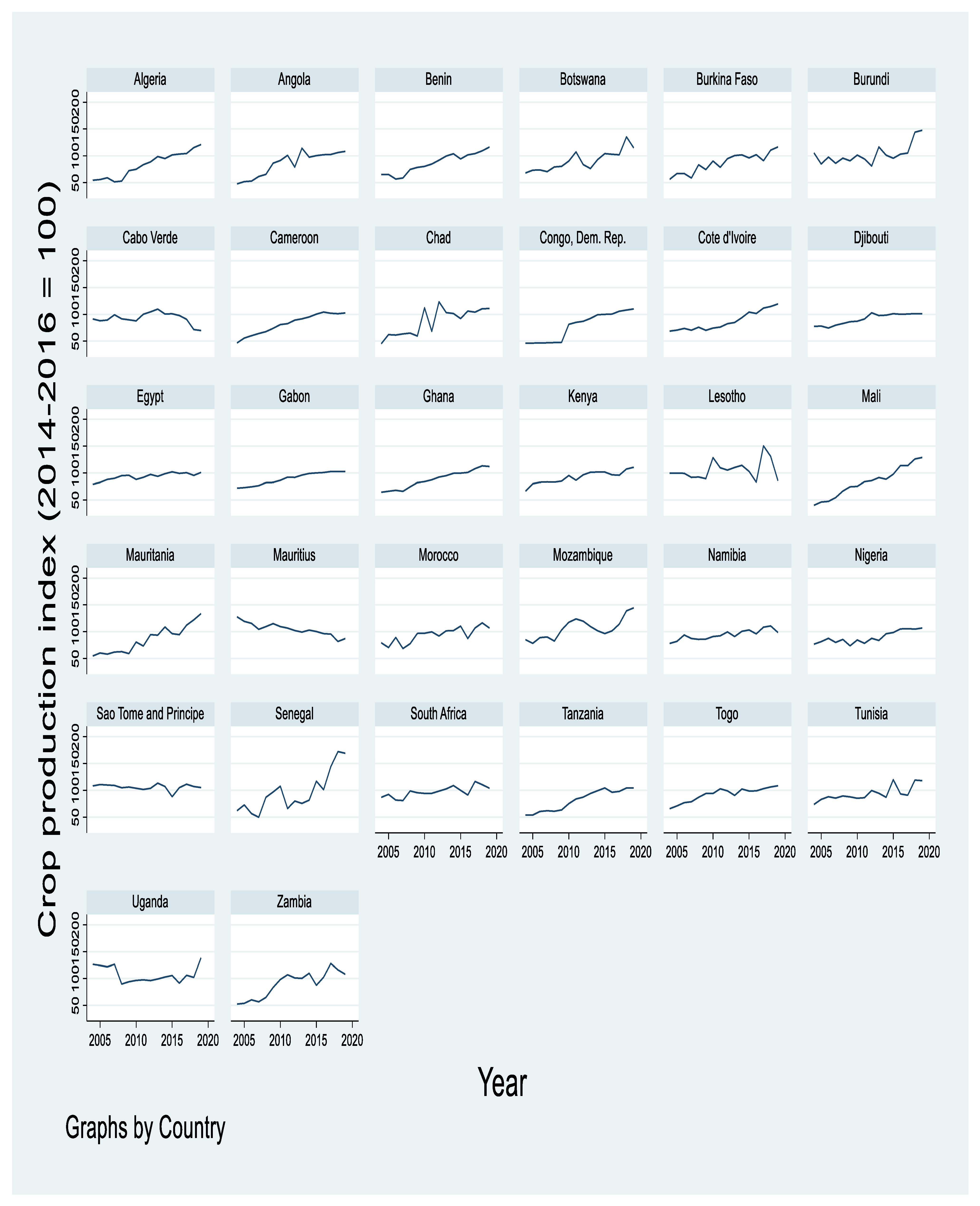

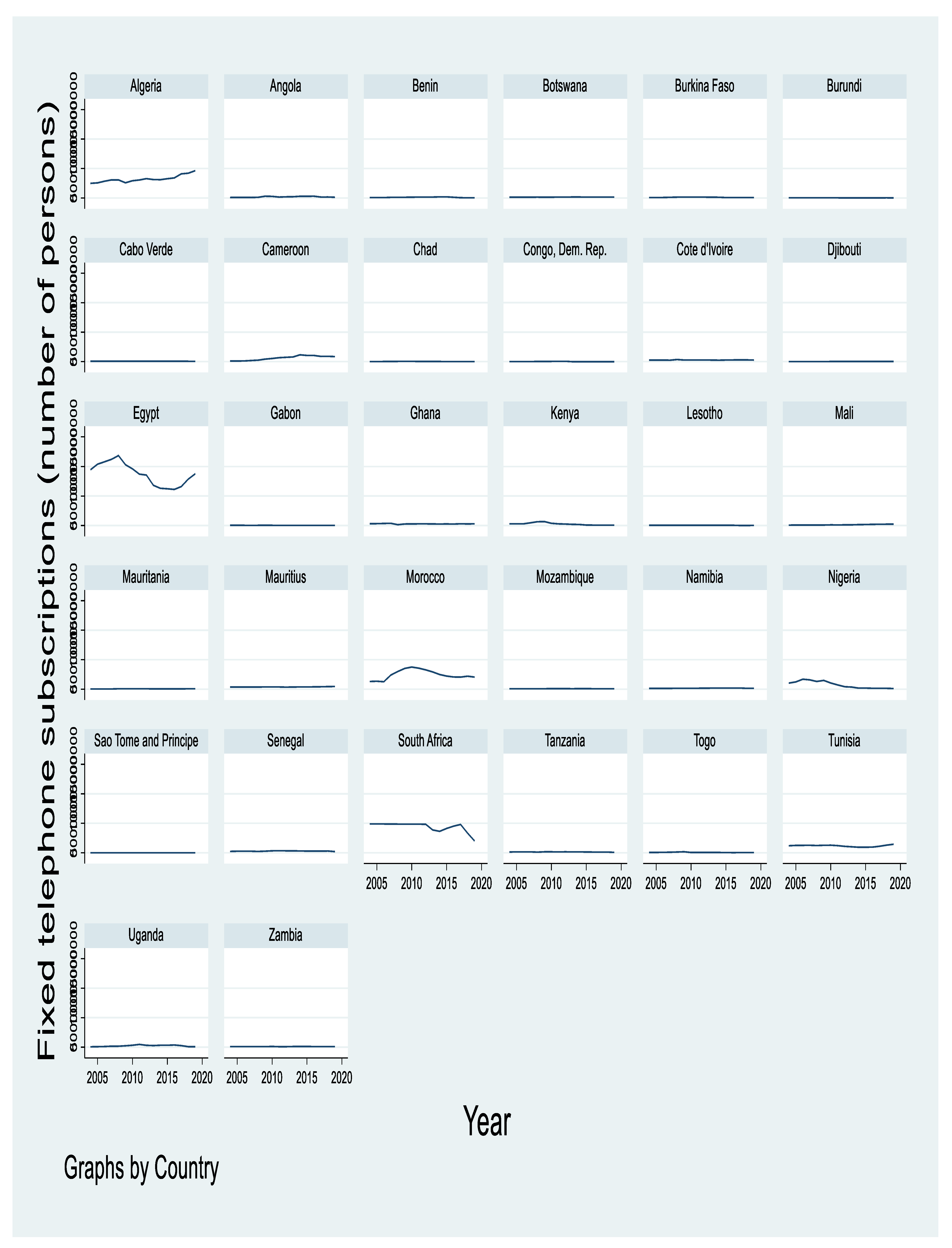
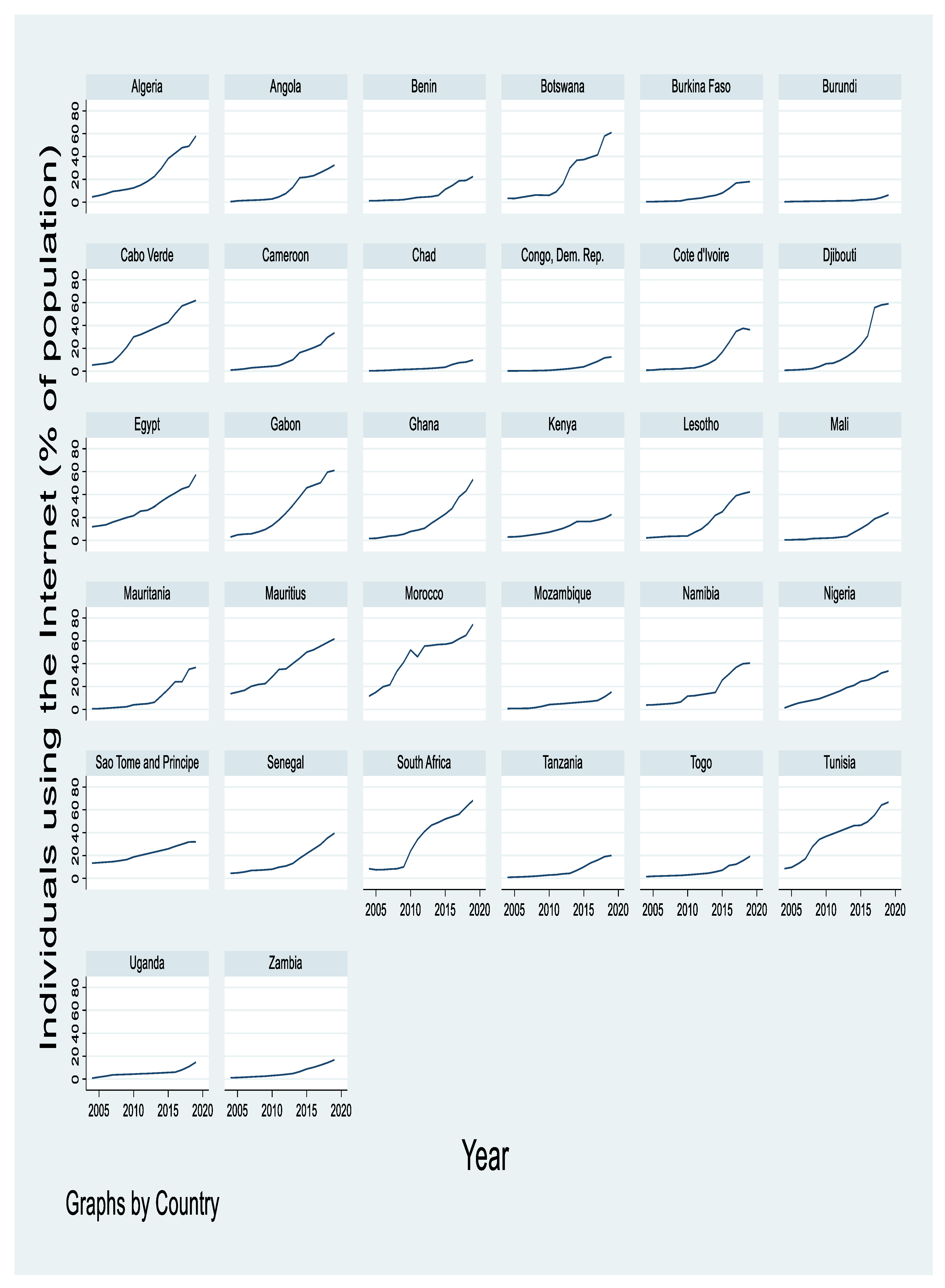
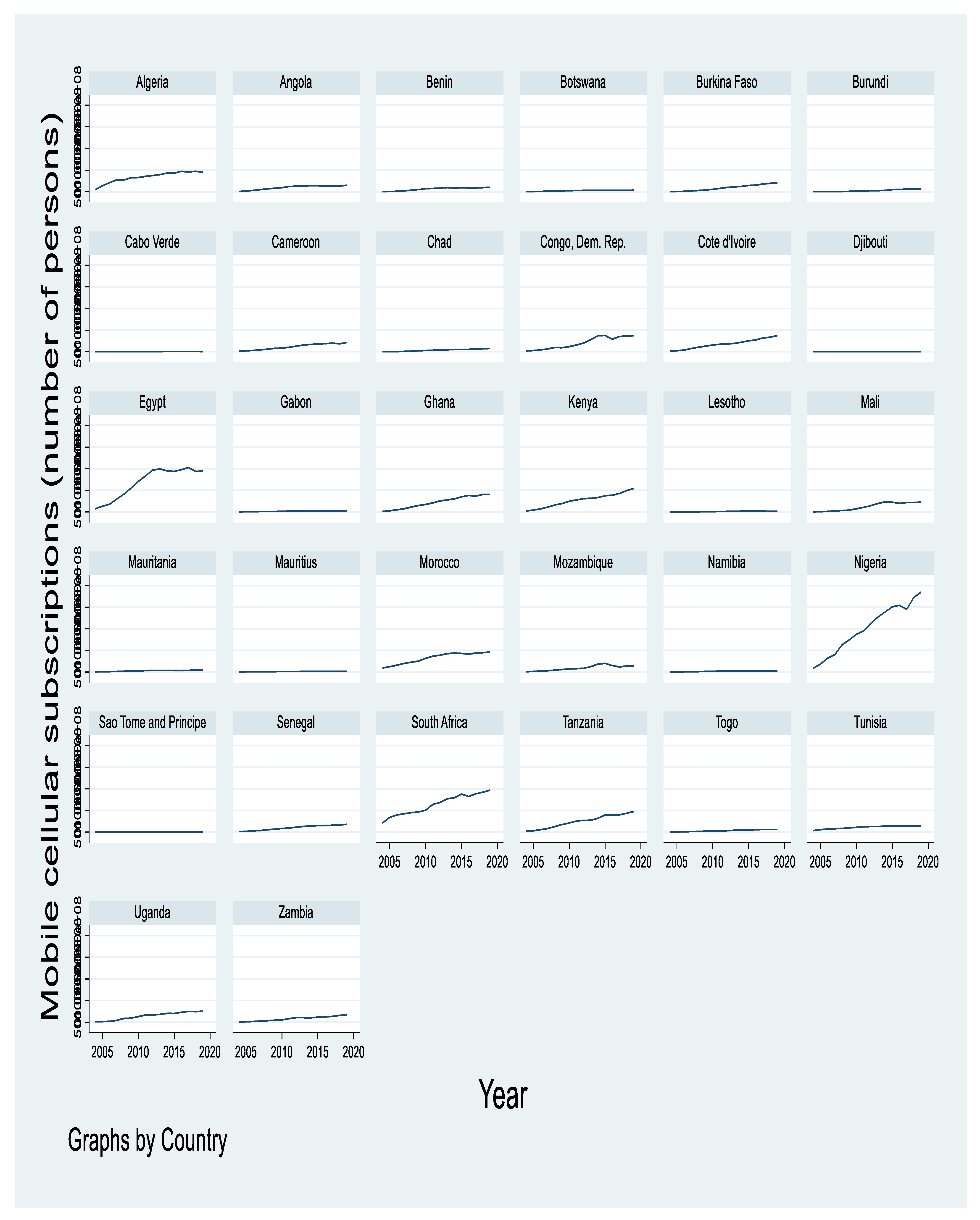

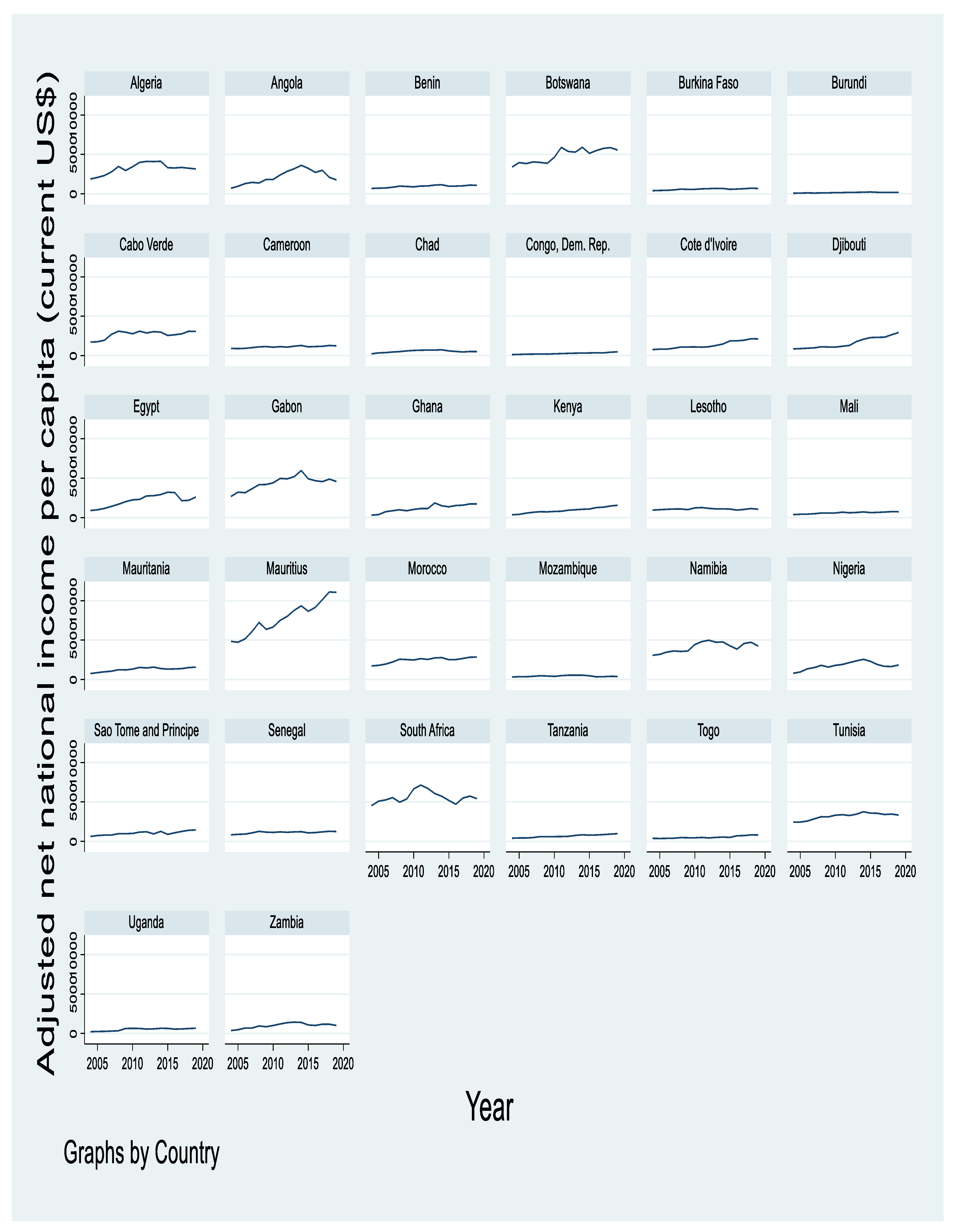
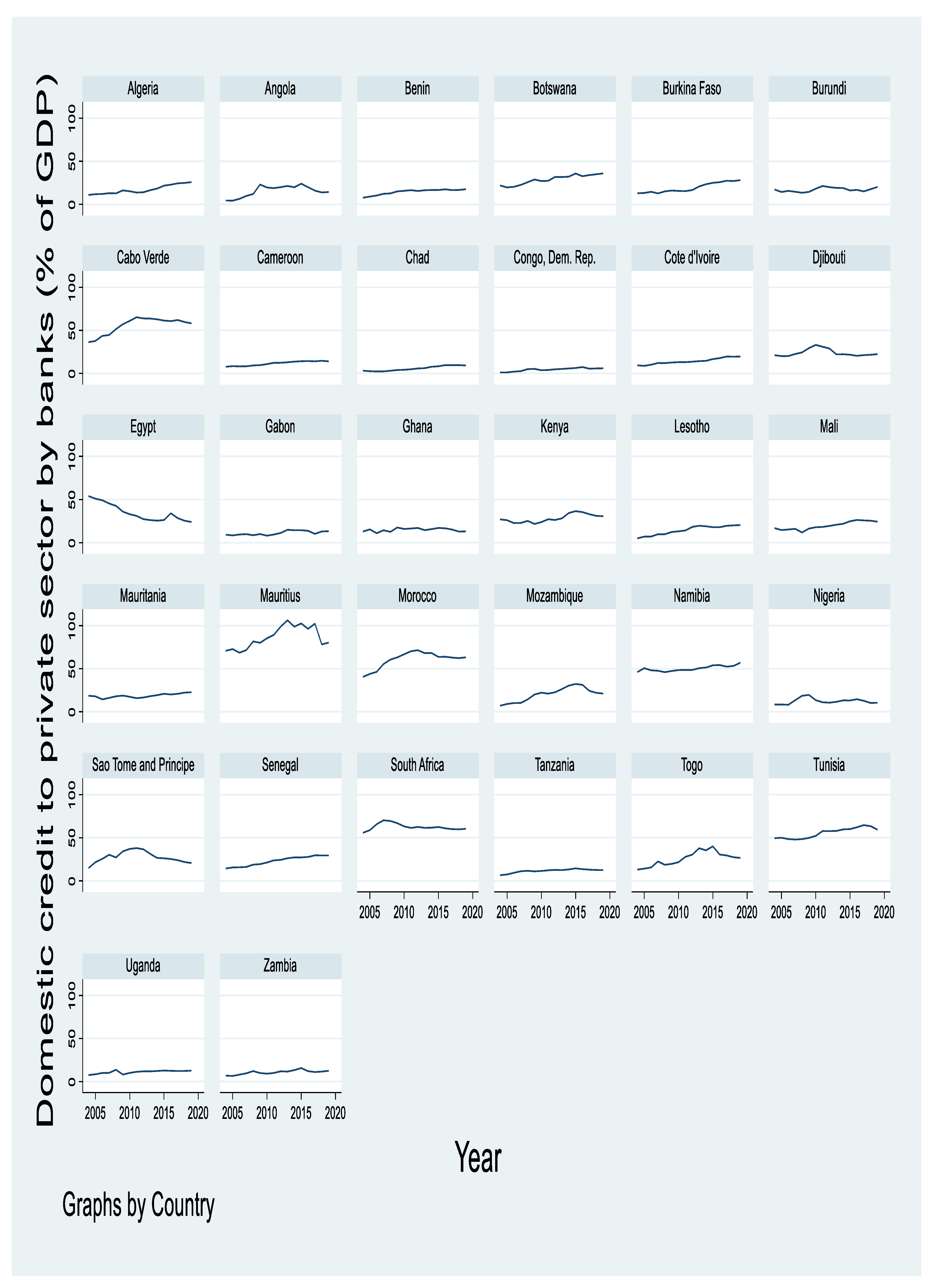
| S/No | Country |
|---|---|
| 1 | Algeria |
| 2 | Angola |
| 3 | Benin |
| 4 | Botswana |
| 5 | Burkina Faso |
| 6 | Burundi |
| 7 | Cape Verde |
| 8 | Cameroon |
| 9 | Chad |
| 10 | Congo Democratic Republic |
| 11 | Côte d’Ivoire |
| 12 | Djibouti |
| 13 | Egypt |
| 14 | Gabon |
| 15 | Ghana |
| 16 | Kenya |
| 17 | Lesotho |
| 18 | Mali |
| 19 | Mauritania |
| 20 | Mauritius |
| 21 | Morocco |
| 22 | Mozambique |
| 23 | Namibia |
| 24 | Nigeria |
| 25 | Sao Tome and Principe |
| 26 | Senegal |
| 27 | South Africa |
| 28 | Tanzania |
| 29 | Togo |
| 30 | Tunisia |
| 31 | Uganda |
| 32 | Zambia |
| Variables | Source |
|---|---|
| Crop production index (2014–2016 = 100) | World Development Indicators of World Bank |
| Fixed telephone subscriptions (number of persons) | World Development Indicators of World Bank |
| Livestock production index (2014–2016 = 100) | World Development Indicators of World Bank |
| Individuals using the internet (% of population) | World Development Indicators of World Bank |
| Mobile cellular subscriptions (number of persons) | World Development Indicators of World Bank |
| Adjusted net national income per capita (current US$) | World Development Indicators of World Bank |
| Domestic credit to private sector by banks (% of GDP) | World Development Indicators of World Bank |
| Rural population (% of population) | World Development Indicators of World Bank |
| Variables | Median | Minimum | Maximum | Mean | Std. Deviation | Skewness | Kurtosis |
|---|---|---|---|---|---|---|---|
| Fixed telephone subscriptions | 138,584.00 | 0.00 | 11,852,539.00 | 769,139.15 | 1,783,668.60 | 3.645 | 14.582 |
| Crop production index (2014–2016 = 100) | 94.67 | 40.18 | 172.26 | 92.0869 | 19.62481 | −0.005 | 0.907 |
| Livestock production index (2014–2016 = 100) | 96.32 | 49.48 | 134.54 | 93.9289 | 14.98644 | −0.163 | 0.568 |
| Individuals using the internet (% of population) | 9.15 | 0.20 | 74.38 | 16.29 | 17.11 | 1.252 | 0.608 |
| Mobile cellular subscriptions | 6,450,319.50 | 7745.00 | 184,592,255.00 | 16,729,760.59 | 26,294,996.51 | 3.042 | 11.313 |
| Adjusted net national income per capita (current USD) | 1151.36 | 65.07 | 11,114.26 | 1915.03 | 1842.35 | 1.857 | 4.121 |
| Domestic credit to private sector by banks (% of GDP) | 18.91 | 1.07 | 106.26 | 25.89 | 20.00 | 1.501 | 1.856 |
| Rural population (% of total population) | 56.02 | 10.26 | 90.86 | 53.71 | 17.66 | −0.165 | −0.501 |
| Variable | CD-Test | p-Value |
|---|---|---|
| lnY1 | 44.00 | 0.000 |
| lnY2 | 43.01 | 0.000 |
| lnX1 | 85.04 | 0.000 |
| lnX2 | 87.02 | 0.000 |
| lnX3 | 7.99 | 0.000 |
| lnX4 | 67.91 | 0.000 |
| lnX5 | 42.08 | 0.000 |
| lnX6 | 23.19 | 0.000 |
| Variable | Variance Inflation Factor (VIF) |
|---|---|
| lnX1 | 1.872 |
| lnX2 | 3.467 |
| lnX3 | 1.891 |
| lnX4 | 3.452 |
| lnX5 | 2.564 |
| lnX6 | 2.090 |
| H0 = All Panels Contain Unit Roots H0 = Series Have a Unit Roots | ||||
| Pesaran’s CADF Test | ||||
| At Level I(0) | At First Difference I(1) | |||
| Variable | t-Statistic | t-Statistic | Decision: H0 | Result |
| lnY1 | −2.255 *** | −3.021 *** | Reject | I(0) at 1% |
| lnY2 | −2.035 ** | −2.503 *** | Reject | I(0) at 5% |
| lnX1 | −2.014 | −2.102 ** | Reject | I(1) at 5% |
| lnX2 | −2.563 *** | −2.956 *** | Reject | I(0) at 1% |
| lnX3 | −1.795 | −2.333 *** | Reject | I(1) at 1% |
| lnX4 | −1.668 | −2.740 *** | Reject | I(1) at 1% |
| lnX5 | −2.185 *** | −2.608 *** | Reject | I(0) at 1% |
| lnX6 | −2.327 *** | −3.399 *** | Reject | I(0) at 1% |
| Im–Pesaran–Shin unit-root test | ||||
| At Level I(0) | At First Difference I(1) | |||
| Variable | t-Statistic | t-Statistic | Decision: H0 | Result |
| lnY1 | −0.8175 | −8.6710 *** | Reject | I(1) at 1% |
| lnY2 | 0.2771 | −5.1729 *** | Reject | I(1) at 1% |
| lnX1 | 0.2727 | −3.3191 *** | Reject | I(1) at 1% |
| lnX2 | −2.3181 ** | −3.5185 *** | Reject | I(0) at 5% |
| lnX3 | 2.0290 | −3.9593 *** | Reject | I(1) at 1% |
| lnX4 | −0.1403 | −5.9441 *** | Reject | I(1) at 1% |
| lnX5 | −0.2970 | −3.9756 *** | Reject | I(1) at 1% |
| lnX6 | 1.000 | −13.347 *** | Reject | I(1) at 1% |
| H0: No Cointegration Ha: All Panels Are Cointegrated | ||||
| Pedroni Test for Cointegration | Crop Production Index | Livestock Production Index | ||
| Test | Statistic | p-Value | Statistic | p-Value |
| Modified Phillips–Perron t Phillips–Perron t Augmented Dickey–Fuller t | 7.6234 | 0.0000 | 8.6877 | 0.0000 |
| −20.8984 | 0.0000 | −9.3796 | 0.0000 | |
| −13.8666 | 0.0000 | −7.5080 | 0.0000 | |
| Westerlund Test for Cointegration | Crop Production | Livestock Production | ||
| Test | Statistic | p-Value | Statistic | p-Value |
| Variance ratio | −1.9163 | 0.03 | −1.5991 | 0.05 |
| Variables | Crop Production | Livestock Production | ||
|---|---|---|---|---|
| PMG | DFE | PMG | DFE | |
| Panel A: Long-Run Estimates | ||||
| lnX1 | 0.071 | 0.148 | 0.017 | 0.039 |
| (10.72) *** | (5.56) *** | (0.97) | (0.91) | |
| lnX2 | −0.022 | −0.017 | 0.077 | 0.106 |
| (−1.97) ** | (−0.50) | (5.17) *** | (1.90) * | |
| lnX3 | −0.031 | −0.015 | −0.079 | 0.008 |
| (−3.87) *** | (−1.28) | (−6.17) *** | (0.41) | |
| lnX4 | 0.079 | 0.001 | 0.106 | 0.018 |
| (4.46) *** | (0.01) | (2.42) ** | (0.15) | |
| lnX5 | 0.006 | 0.141 | 0.392 | 0.009 |
| (0.44) | (2.34) ** | (6.72) *** | (0.09) | |
| lnX6 | −0.293 | −0.183 | 1.507 | 0.022 |
| (−10.34) *** | (−0.72) | (5.99) *** | (0.05) | |
| Panel B: Short-Run Estimates | ||||
| ECT | 0.690 | 0.481 | 0.191 | 0.170 |
| (6.47) *** | (11.94) *** | (4.42) *** | (6.16) *** | |
| ΔlnX1 | −0.051 | −0.043 | −0.018 | 0.003 |
| (−1.14) | (−1.22) | (−0.38) | (0.14) | |
| ΔlnX2 | 0.120 | 0.007 | 0.008 | 0.007 |
| (1.96) ** | (0.17) | (0.27) | (0.27) | |
| ΔlnX3 | −0.089 | −0.002 | −0.014 | 0.0002 |
| (−1.77) * | (−0.19) | (−0.25) | (0.03) | |
| ΔlnX4 | 0.102 | 0.091 | −0.005 | 0.038 |
| (0.87) | (1.79)* | (−0.08) | (1.31) | |
| ΔlnX5 | 0.022 | −0.038 | −0.003 | −0.006 |
| (0.19) | (−0.88) | (−0.06) | (−0.23) | |
| ΔlnX6 | 1.969 | −0.247 | 0.656 | −0.061 |
| (1.33) | (−0.22) | (0.78) | (−0.10) | |
| Constant | −3.857 | −2.335 | 0.754 | −0.404 |
| (−6.27) *** | (−4.14) * | (4.87) *** | (−1.29) | |
| Observations | 512 | 512 | 512 | 512 |
| Hausman test of poolability (H0: difference in coefficients not systematic) | ||||
| Crop production | Livestock production | |||
| PMG and DFE | PMG and DFE | |||
| 2.32 | 0.07 | |||
| p-value | 0.8885 | 1.000 | ||
| Decision | The PMG is preferred over the DFE | The PMG is preferred over the DFE | ||
| Hypothesis | Z-Bar | Z-Bar Tilde | Conclusion |
|---|---|---|---|
| lnY1 → lnX1 | 4.5283 *** | 14.1133 *** | Bidirectional causality identified between crop production and individuals using internet |
| lnX1 → lnY1 | 5.2503 *** | 3.1627 *** | |
| lnY1 → lnX2 | 14.7412 *** | 9.9076 *** | Bidirectional causality identified between crop production and mobile phone subscriptions |
| lnX2 → lnY1 | 3.3658 *** | 1.8234 * | |
| lnY1 → lnX3 | 7.8396 *** | 5.0028 *** | Bidirectional causality identified between crop production and fixed telephone subscriptions |
| lnX3 → lnY1 | 3.9543 *** | 2.2417 ** | |
| lnY1 → lnX4 | 5.4957 *** | 3.3371 *** | Bidirectional causality identified between crop production and net national income |
| lnX4 → lnY1 | 3.4100 *** | 1.8549 * | |
| lnY1 → lnX5 | 6.8778 *** | 4.3193 *** | Bidirectional causality identified between crop production and domestic credit to the private sector |
| lnX5 → lnY1 | 2.9885 *** | 1.5553 | |
| lnY1 → lnX6 | 13.5463 *** | 9.0584 *** | Unidirectional causality identified. Crop production index does Granger cause rural population while rural population does not Granger cause crop production index. |
| lnX6 → lnY1 | −0.2653 | −0.7570 | |
| lnY2 → lnX1 | 4.5346 *** | 2.6541 *** | Bidirectional causality identified between livestock production and individuals using internet |
| lnX1 → lnY2 | 4.4845 *** | 2.6185 *** | |
| lnY2 → lnX2 | 5.4399 *** | 3.2975 *** | Unidirectional causality identified. Livestock production Granger cause mobile phone subscriptions, however mobile phone subscriptions does not Granger cause livestock production |
| lnX2 → lnY2 | 1.0341 | 0.1664 | |
| lnY2 → lnX3 | 1.6378 | 0.5954 | Unidirectional causality identified. Livestock production does not Granger cause fixed telephone subscriptions, however fixed telephone subscriptions does Granger cause livestock production |
| lnX3 → lnY2 | 6.4053 *** | 3.9835 *** | |
| lnY2 → lnX4 | 1.5409 | 0.5265 | Unidirectional causality identified. Livestock production does not Granger cause net national income, however net national income does Granger cause livestock production |
| lnX4 → lnY2 | 2.1615 ** | 0.9676 | |
| lnY2 → lnX5 | 1.3615 | 0.3991 | Unidirectional causality identified. Livestock production does not Granger cause domestic credit to the private sector, however domestic credit to the private sector does Granger cause livestock production. |
| lnX5 → lnY2 | 3.4853 *** | 1.9083 * | |
| lnY2 → lnX6 | 7.0168 *** | 4.4181 *** | Unidirectional causality identified. Livestock production index does Granger cause rural population while rural population does not Granger cause livestock production index. |
| lnX6 → lnY2 | 1.0497 | 0.1775 | |
| lnX1 → lnX2 | 7.0461 *** | 4.4389 *** | Bidirectional causality identified between individuals using internet and mobile cellular phone subscriptions |
| lnX2 → lnX1 | 12.6614 *** | 8.4295 *** | |
| lnX1 → lnX3 | 5.9593 *** | 3.6666 *** | Bidirectional causality identified between individuals using the internet and fixed telephone subscriptions |
| lnX3 → lnX1 | 8.7208 *** | 5.6291 *** | |
| lnX1 → lnX4 | 6.5856 *** | 4.1116 *** | Bidirectional causality identified between individuals using the internet and net national income |
| lnX4 → lnX1 | 5.0373 *** | 3.0113 *** | |
| lnX1 → lnX5 | 3.8857 *** | 2.1929 ** | Bidirectional causality identified between individuals using the internet and domestic credit to the private sector |
| lnX5 → lnX1 | 9.6742 *** | 6.3066 *** | |
| lnX1 → lnX6 | 13.9557 *** | 9.3493 *** | Bidirectional causality identified between individuals using the internet and rural population |
| lnX6 → lnX1 | 8.6073 *** | 5.5484 *** | |
| lnX2 → lnX3 | −0.2384 | −0.7380 | Unidirectional causality identified. Mobile cellular phone subscriptions does not Granger cause fixed telephone subscriptions, however fixed telephone subscriptions does Granger cause mobile cellular phone subscriptions |
| lnX3 → lnX2 | 5.5889 *** | 3.4033 *** | |
| lnX2 → lnX4 | 1.1834 | 0.2725 | Unidirectional causality identified. Mobile cellular phone subscriptions does not Granger cause net national income, however net national income does Granger cause mobile cellular phone subscriptions |
| lnX4 → lnX2 | 5.6951 *** | 3.4788 *** | |
| lnX2 → lnX5 | 3.8833 *** | 2.1912 ** | Bidirectional causality identified between mobile cellular phone subscriptions and domestic credit provided to the private sector by banks |
| lnX5 → lnX2 | 13.7153 *** | 9.1785 *** | |
| lnX2 → lnX6 | 2.9612 *** | 1.5359 | Bidirectional causality identified between mobile cellular phone subscriptions and rural population |
| lnX6 → lnX2 | 2.2326 ** | 1.0181 | |
| lnX3 → lnX4 | 5.7472 *** | 3.5158 *** | Bidirectional causality identified between fixed telephone subscriptions and net national income |
| lnX4 → lnX3 | 2.0032 ** | 0.8551 | |
| lnX3 → lnX5 | 8.8024 *** | 5.6871 *** | Bidirectional causality identified between fixed telephone subscriptions and domestic credit provided to the private sector by banks |
| lnX5 → lnX3 | 7.8753 *** | 5.0282 *** | |
| lnX3 → lnX6 | 9.2821 *** | 6.0279 *** | Unidirectional causality identified. Fixed telephone subscriptions does Granger cause rural population while rural population does not Granger cause fixed telephone subscriptions. |
| lnX6 → lnX3 | −0.3902 | −0.8459 | |
| lnX4 → lnX5 | 2.1153 *** | 0.9347 | Bidirectional causality identified between net national income and domestic credit provided to the private sector by banks |
| lnX5 → lnX4 | 13.3666 *** | 8.9307 *** | |
| lnX4 → lnX6 | 3.3663 *** | 1.8238 * | Unidirectional causality identified. Net national income does Granger cause rural population while rural population does not Granger cause net national income. |
| lnX6 → lnX4 | 0.7951 | −0.0034 | |
| lnX5 → lnX6 | 7.5513 *** | 4.7979 *** | Bidirectional causality identified between domestic credit provided to the private sector by banks and rural population |
| lnX6 → lnX5 | 1.8286 * | 0.7310 |
Disclaimer/Publisher’s Note: The statements, opinions and data contained in all publications are solely those of the individual author(s) and contributor(s) and not of MDPI and/or the editor(s). MDPI and/or the editor(s) disclaim responsibility for any injury to people or property resulting from any ideas, methods, instructions or products referred to in the content. |
© 2023 by the authors. Licensee MDPI, Basel, Switzerland. This article is an open access article distributed under the terms and conditions of the Creative Commons Attribution (CC BY) license (https://creativecommons.org/licenses/by/4.0/).
Share and Cite
Onyeneke, R.U.; Ankrah, D.A.; Atta-Ankomah, R.; Agyarko, F.F.; Onyeneke, C.J.; Nejad, J.G. Information and Communication Technologies and Agricultural Production: New Evidence from Africa. Appl. Sci. 2023, 13, 3918. https://doi.org/10.3390/app13063918
Onyeneke RU, Ankrah DA, Atta-Ankomah R, Agyarko FF, Onyeneke CJ, Nejad JG. Information and Communication Technologies and Agricultural Production: New Evidence from Africa. Applied Sciences. 2023; 13(6):3918. https://doi.org/10.3390/app13063918
Chicago/Turabian StyleOnyeneke, Robert Ugochukwu, Daniel Adu Ankrah, Richmond Atta-Ankomah, Fred Fosu Agyarko, Chinenye Judith Onyeneke, and Jalil Ghassemi Nejad. 2023. "Information and Communication Technologies and Agricultural Production: New Evidence from Africa" Applied Sciences 13, no. 6: 3918. https://doi.org/10.3390/app13063918
APA StyleOnyeneke, R. U., Ankrah, D. A., Atta-Ankomah, R., Agyarko, F. F., Onyeneke, C. J., & Nejad, J. G. (2023). Information and Communication Technologies and Agricultural Production: New Evidence from Africa. Applied Sciences, 13(6), 3918. https://doi.org/10.3390/app13063918










